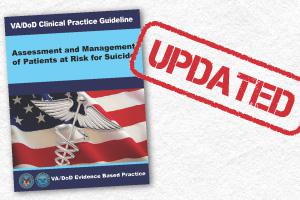By Jennifer Tucker, Ph.D.
Aug. 13, 2019
 PHCoE graphic
PHCoE graphic
The Department of Defense (DOD) today released the 2019 VA/DOD Clinical Practice Guideline for the Assessment and Management of Patients at Risk for Suicide. This clinical practice guideline (CPG) is the result of a thorough review of recently published evidence for suicide interventions by a multidisciplinary panel of experts. The CPG'ss recommendations are intended for dissemination among and implementation by providers who care for military service members and veterans.
Below is a summary of the CPG's main recommendations for the identification of suicide risk, evaluation of risk level, and management of patients at risk for suicide. Providers are encouraged to consult the full CPG for more details about these recommendations.
Identification of suicide risk (Algorithm A)
An evidence-based, recommended screening tool – such as item 9 of the Patient Health Questionnaire-9 – should be administered to individuals who …
- Exhibit warning signs, such as suicidal ideation or recent self-directed violence (suicide attempt or intentional self-injury)
- Are identified as at-risk for suicide by computer-driven prediction models (e.g., VA's REACH VET program)
- Present in a setting in which routine suicide screening is used (e.g., behavioral health)
If the suicide screen is positive or if there is evidence that suggests the need for additional screening or evaluation, then the provider assesses for safety concerns like access to a firearm or a detailed suicide plan.
- For individuals with safety concerns that require immediate management, initiate management procedures for High Acute Risk for suicide
- For all other individuals with suicide risk, initiate evaluation procedures
Evaluation by provider (Algorithm B)
The evaluation is used to gather information to determine the patient's current suicide risk level so that management procedures matched to that risk level can be initiated.
A comprehensive evaluation of suicide risk must include an assessment of:
- Current suicidal ideation
- Ability to maintain safety
- Intent to die by suicide
- Prior suicide attempt(s)
- Current psychiatric conditions and symptoms
- Prior psychiatric hospitalization
- Recent bio-psychosocial stressors
- Availability of firearms
The provider will map the results of his/her evaluation to the following risk levels:
High Acute Risk
- Suicidal thoughts with intent to die by suicide
- Requires external assistance to maintain personal safety
Intermediate Acute Risk
- Suicidal thoughts with intent to die by suicide
- Ability to independently maintain personal safety
Low Acute Risk
- No current suicidal thoughts, specific suicide plan, or preparatory suicide behaviors
- Ability to independently maintain personal safety
Management of patients at acute risk of suicide (Algorithm C)
Below are a subset of the CPG's recommended actions for providers, organized by suicide risk level.
High Acute Risk
- Initiate direct observation of the patient and ensure patient has no access to lethal means (e.g., sharps, cords, tubing, toxic substances, firearms)
- Hospitalization of the patient is typically required for safety, including involuntary hospitalization
- During hospitalization, initiate evidence-based treatment aimed at reducing suicide risk
- Discharge only if risk level has sufficiently decreased
- Following discharge, consider checking in on the patient via telephone, home visit, or mail (depending on your clinic's policy and procedures) and assisting the patient with engaging in case management services as well as counseling or other psychosocial interventions
Intermediate Acute Risk
- Hospitalization may be indicated after considering the ability to maintain safety as well as the risks and benefits of outpatient and inpatient care
- Outpatient management should include frequent contact with the patient, a carefully constructed safety plan, and the involvement of the patient's support network whenever possible
- Mental health treatment should address co-occurring conditions and concerns
- Re-evaluate risk level regularly and adjust management plan accordingly
Low Acute Risk
- Patient can be managed in primary care
- Outpatient mental health may be indicated, especially with co-occurring suicidal ideation and psychiatric symptoms
- Focus care on strengthening protective factors and mitigating risk factors
- Re-evaluate risk level regularly and adjust management plan accordingly
We hope this blog increases your knowledge of the latest, evidence-based suicide intervention procedures to be used with military service members and veterans. In the coming months, our team will develop and publish tools to help clinicians better understand, remember, and ultimately implement the CPG's recommendations. We'll also develop non-clinical tools to help patients, family members, and military leaders better understand evidence-based suicide care. We'll keep you updated on the availability of these tools in future blogs (sign up for e-mail delivery) and on our Facebook page.
--------------------
Dr. Tucker is a suicide prevention subject matter expert at the Psychological Health Center of Excellence. She has a master's degree and doctorate in clinical psychology and has worked with service members hospitalized for suicide risk.